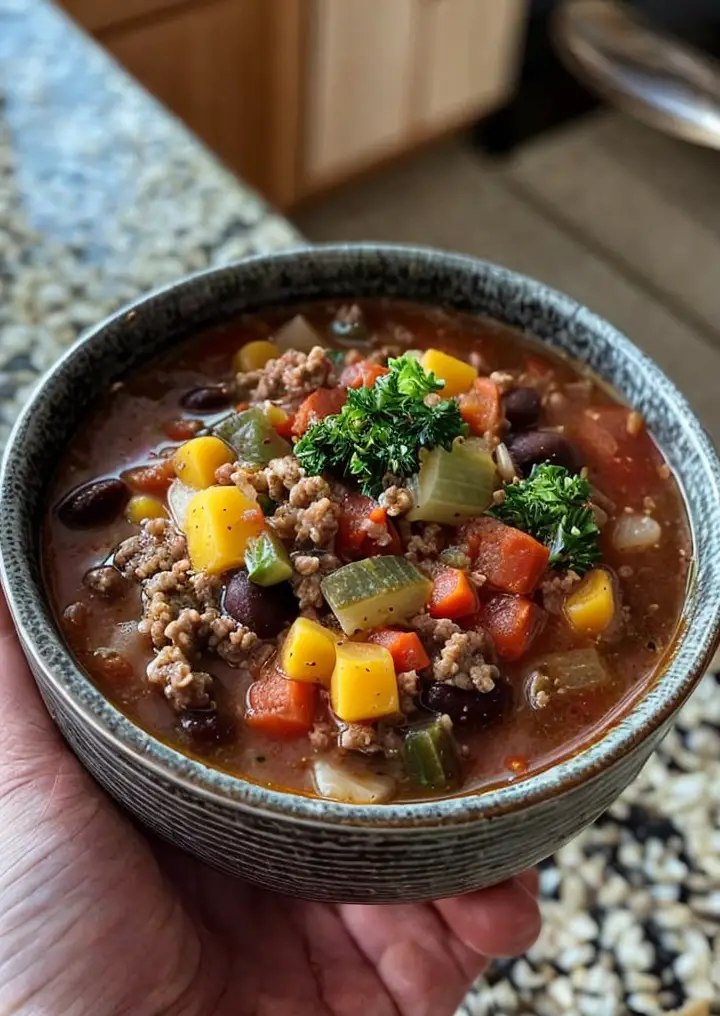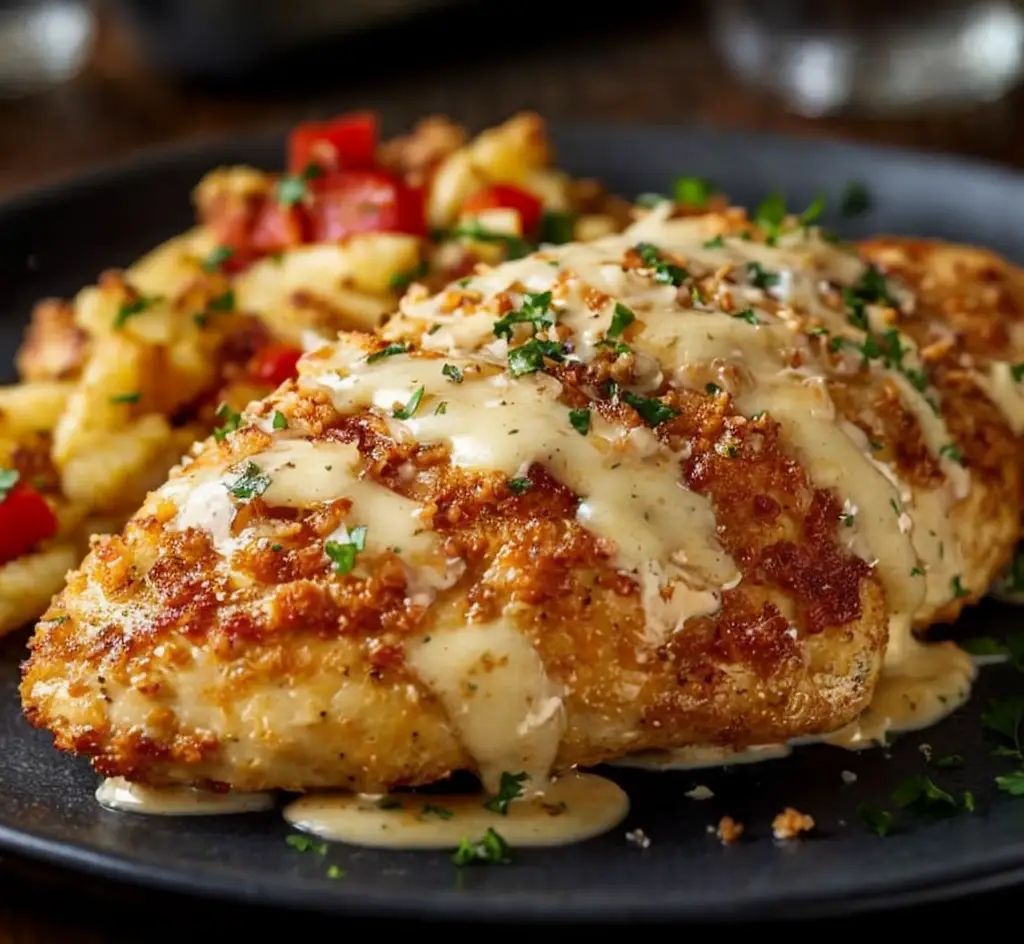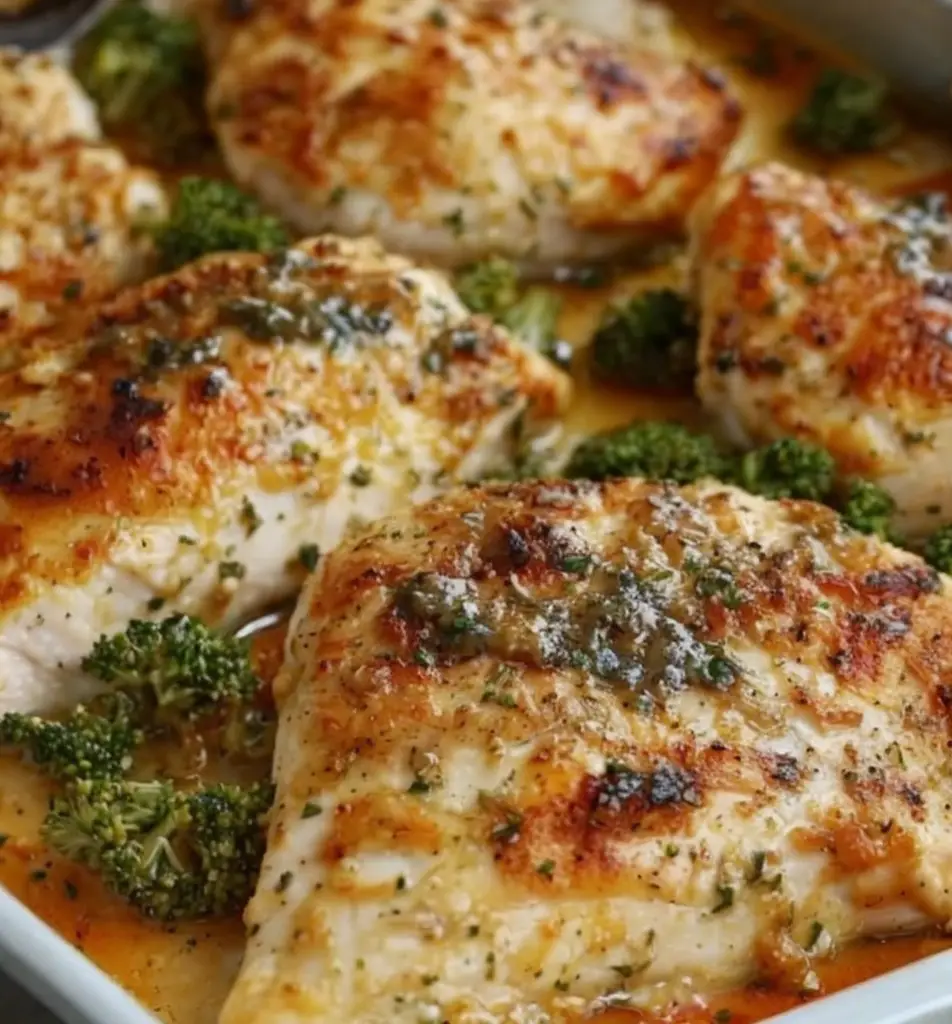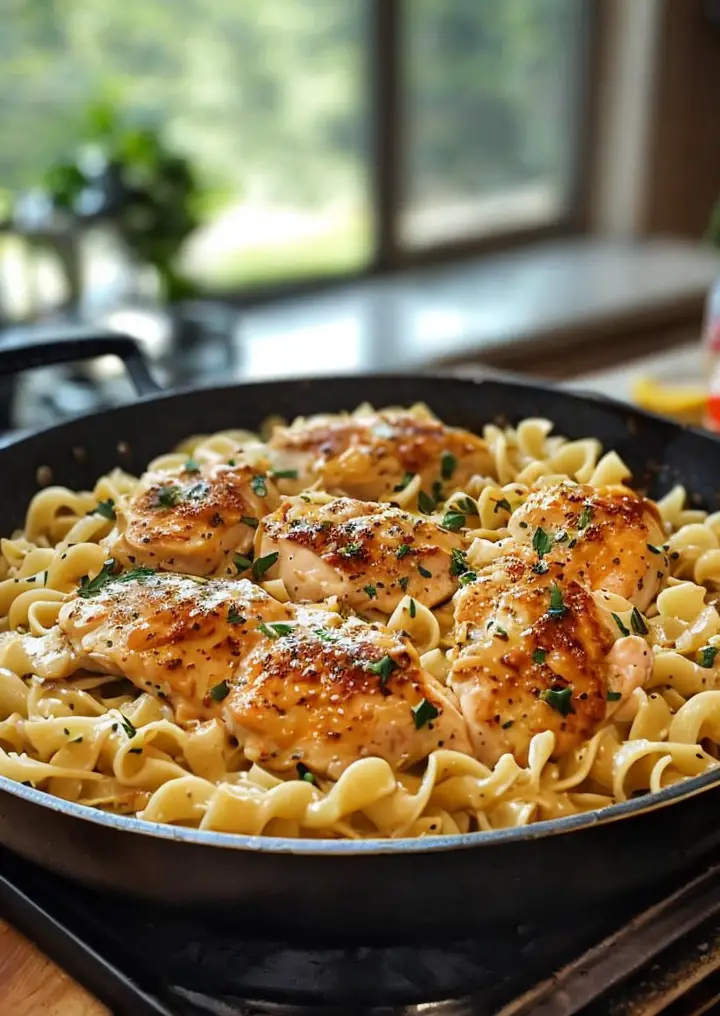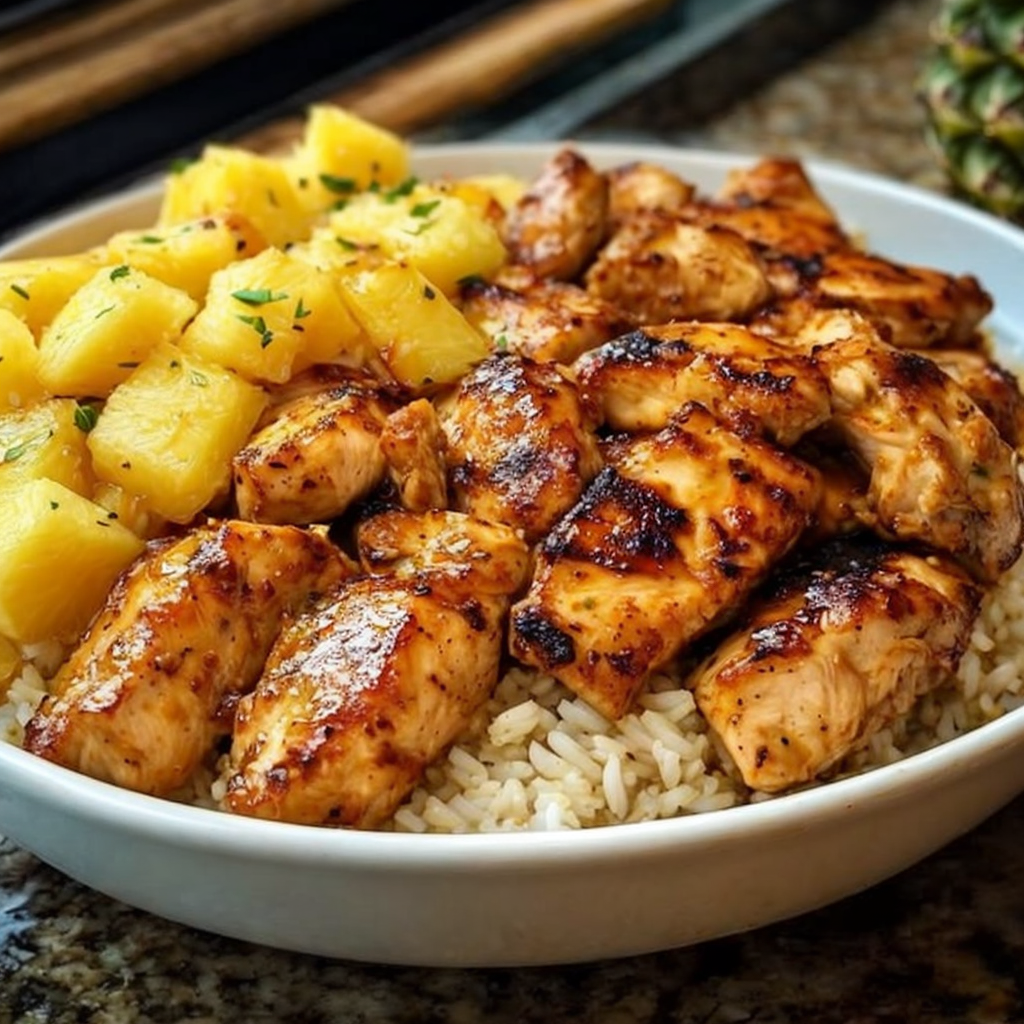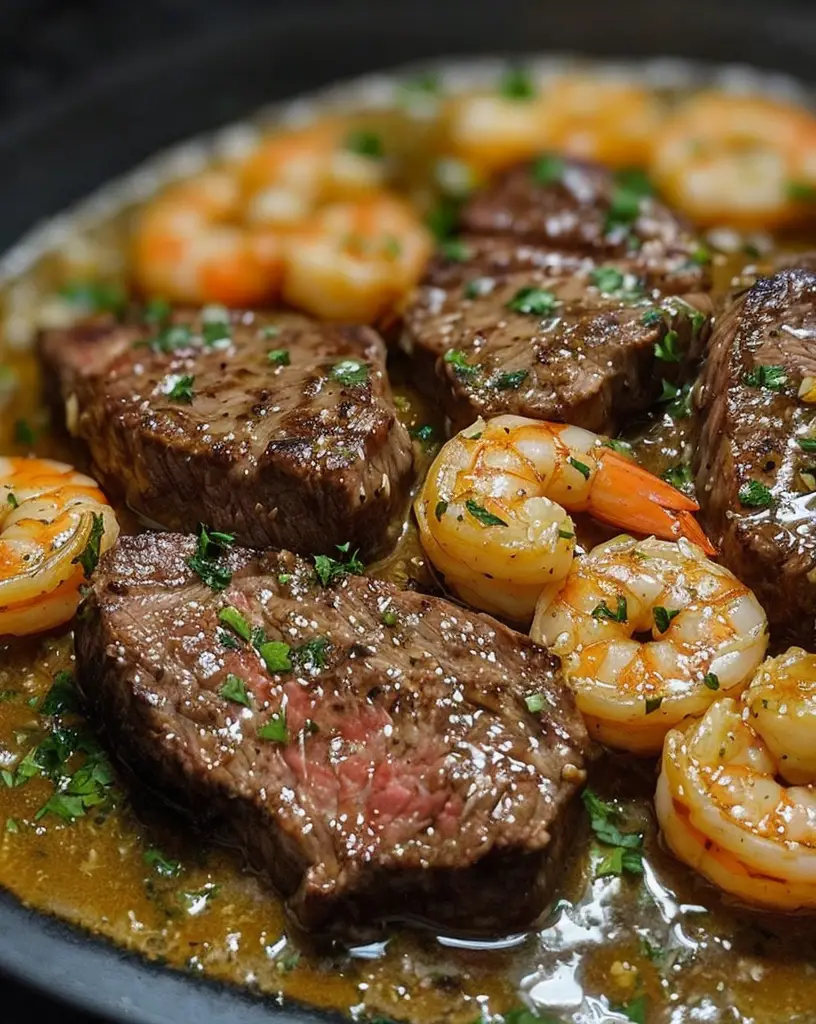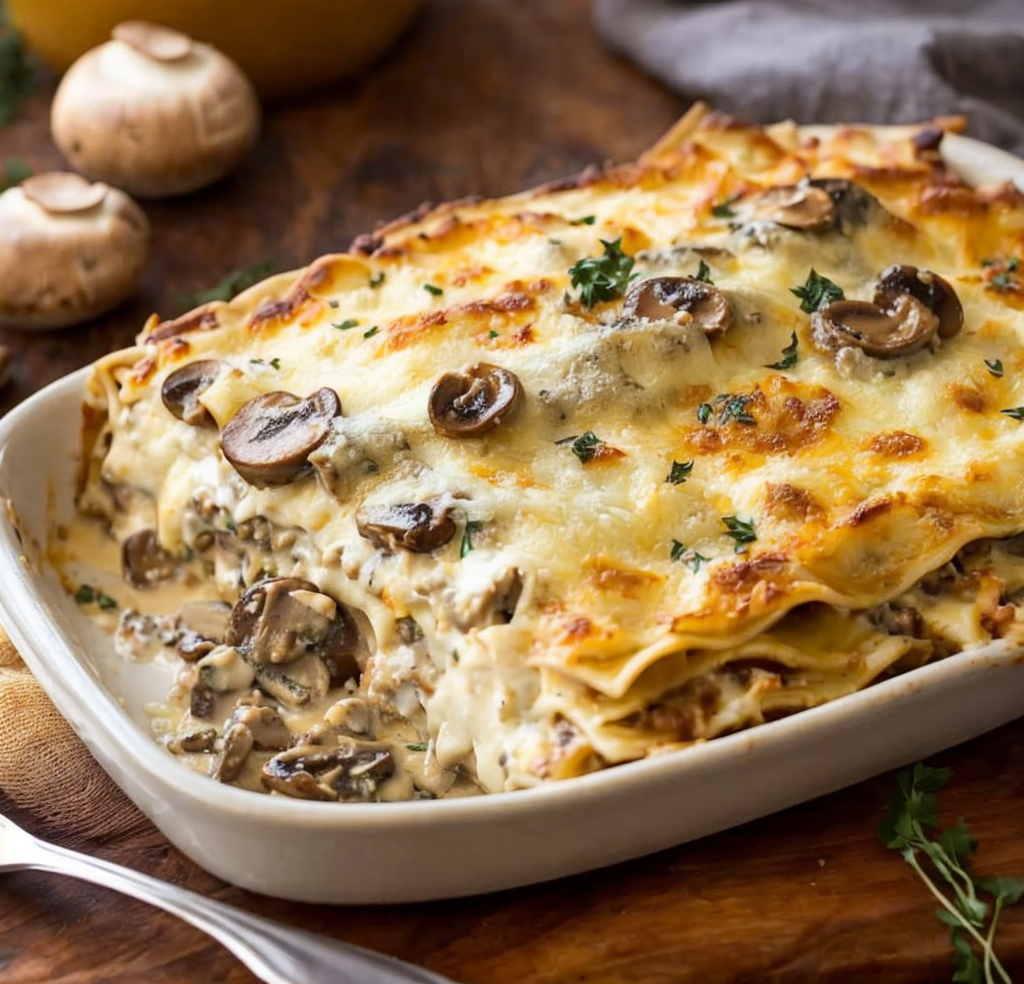Delicious Ground Beef Vegetable Soup: A Comforting Dish for Any Day
Ground Beef Vegetable Soup is the ultimate dish for a comforting meal that warms both the body and soul. This hearty soup is a delightful blend of tender ground beef, a medley of fresh vegetables, and robust spices that create a flavor profile bursting with richness. Imagine spoonfuls of savory goodness, perfectly seasoned, and filled with nutritious ingredients. Whether you enjoy it on a chilly evening or as a nourishing lunch, this soup is a family favorite that appeals to all ages.
One of the best features of this Ground Beef Vegetable Soup recipe is its versatility. You can customize it with your favorite vegetables, ensuring it suits your taste preferences and whatever is in season. It’s not just a meal; it’s a canvas for creativity in the kitchen. In just a matter of minutes, you can prepare this soul-soothing soup that evokes feelings of warmth and joy, making it perfect for gatherings or simply to enjoy at home.
Quick Recipe Highlights
- Flavor Profile: This soup features a harmonious blend of savory ground beef and a variety of fresh vegetables, providing a balance of hearty flavors and subtle sweetness.
- Texture: Each bowl offers a delightful texture, from the tender beef to the crisp vegetables, creating an enjoyable mouthfeel.
- Aroma: The smell of this soup as it cooks is irresistible, with fragrant herbs and spices wafting through the air, instantly tantalizing your senses.
- Visual Appeal: Rich colors from the vegetables and broth make this dish visually appealing, presenting a vibrant bowl filled with nature’s bounty.
- Skill Level Needed: This recipe is designed for all cooking skill levels, making it an excellent choice for beginner cooks as well as more experienced chefs.
- Special Equipment: You’ll need a large pot or Dutch oven, along with standard kitchen utensils like a knife and chopping board.
Recipe Overview
- Difficulty Level: The Ground Beef Vegetable Soup is categorized as easy, perfect for those who may not have extensive cooking experience but want to prepare something delicious.
- Category: This recipe fits into the comfort food category, ideal for family dinners, particularly in colder months when you crave something hearty.
- Cuisine: Rooted in traditional American cuisine, this soup draws inspiration from various cultures that appreciate rich, filling dishes.
- Cost: Ingredients for this soup are generally economical, with an average cost that makes it accessible for everyday home cooking.
- Season: While this soup is perfect year-round, it shines particularly in fall and winter when fresh vegetables are in season, adding to its vibrant flavor.
- Occasion: It’s suitable for casual family dinners, potlucks, or even served as a starter at more formal gatherings.
Why You’ll Love This Recipe
This Ground Beef Vegetable Soup not only tastes amazing but has rich, satisfying textures that keep you coming back for more. The combination of savory beef with the vibrant crunch of assorted vegetables creates a delightful mouthfeel that is simply irresistible. It strikes a perfect balance between heartiness and comfort, providing the satisfaction of a warm meal without being heavy.
In addition to its delicious flavor, this recipe is incredibly convenient and easy to prepare. Within under an hour, you can have a steaming pot of soup ready to serve. Its straightforward steps make it an excellent meal for busy weeknights when you want to serve something wholesome without spending all day in the kitchen. Plus, it’s a great way to use up any leftover vegetables in your fridge!
From a nutritional perspective, Ground Beef Vegetable Soup is an all-around winner. Packed with protein from the ground beef and a variety of nutrients from the vegetables, this soup supports a balanced diet. It can contribute to your daily intake of vitamins and minerals while also offering satisfying calories to keep you feeling full and energized.
Socially, this soup brings people together. It’s the kind of dish that invites conversation and can easily be scaled up to feed a crowd. Perfect for parties or family dinners, sharing a bowl of this comforting soup can create lasting memories. Plus, serving freshly baked bread on the side takes the experience to a whole new level!
Finally, cost-effectiveness is another reason why you will love this recipe. Ground beef and seasonal vegetables can be purchased at an affordable price, making this soup a budget-friendly option for families and anyone looking to save while enjoying a nourishing meal. With just a little planning, you can create a delicious dish that doesn’t break the bank.
Historical Background and Cultural Significance
Ground Beef Vegetable Soup has a rich historical background that reflects the comforts of home cooking. Originating in households around America, this dish exemplifies the principles of using whatever ingredients are on hand to create something delicious. Its evolution over the years has seen many variations, each shaped by regional preferences and available produce.
Culturally, this soup holds a special place in American kitchens, often served during family gatherings and community events. It serves as an anchor point for many cherished family recipes, passed down through generations, and evoking memories of warmth, comfort, and togetherness.
The versatility of Ground Beef Vegetable Soup has led to unique regional variations. In the Midwest, ingredients such as corn and potatoes may be common, while coastal areas might prefer chardonnay-flavored broth with seafood tips. This adaptability ensures the soup remains a staple in many diets across the country.
With the rise of culinary awareness, the recipe has evolved into many versions, including vegetarian adaptations and gourmet styles that showcase premium ingredients. This evolution attests to the dish’s enduring appeal and adaptability in contemporary cooking.
Ingredient Deep Dive
For the key ingredient, ground beef, its cultural significance stems from its role as an affordable protein choice that supports a variety of hearty dishes. Ground beef provides essential nutrients and is often chosen for its ability to absorb flavors well. When selecting, look for lean cuts to ensure your soup remains healthy. Store it in the refrigerator for up to two days or freeze for longer preservation.
Vegetables like carrots, celery, and peas play a vital role in grounding the dish while adding flavor and nutrition. These ingredients are often celebrated in many cultural cuisines for their richness in vitamins and minerals. When purchasing, opt for fresh, vibrant produce, and store them in a cool, dark place. You can substitute these vegetables according to the season, so feel free to experiment with what’s available.
Each ingredient in this recipe contributes to a nutritional profile that supports overall health, making it a smart choice for everyday meals. It’s a great way to include a variety of food groups in one wholesome dish.
Common Mistakes to Avoid
- Not browning the beef properly: Ensure that you brown the ground beef until fully cooked to enhance flavor and depth.
- Overcooking vegetables: Add denser vegetables first and softer ones later to maintain texture and prevent mushiness.
- Skipping seasoning: Don’t omit spices! Season in layers to build flavor throughout the cooking process.
- Using water instead of broth: Always use a good-quality broth for a rich, flavorful soup that enhances the overall taste.
- Ignoring leftovers: This soup stores beautifully, so don’t hesitate to batch cook for easy meals later.
- Piling too many ingredients: Balance the variety of vegetables to ensure a smooth cooking process without overcrowding the pot.
- Not allowing it to simmer: Allow sufficient simmering time to let the flavors meld together beautifully.
- Skipping the garnish: A sprinkle of fresh herbs or croutons can elevate the dish significantly, adding visual appeal and additional flavor.
Essential Techniques
Browning the ground beef is essential for developing deep, savory flavors in your Ground Beef Vegetable Soup. This technique is vital as it allows the Maillard reaction to occur, creating complex tastes. To master this, ensure your pot is sufficiently hot before adding the beef, and resist the urge to stir too frequently to allow for a robust caramelization.
Properly chopping vegetables is also crucial for ensuring even cooking and presentation. Aim for uniform pieces to ensure they cook at the same rate. Use a sharp knife and practice your knife skills to achieve those perfect cuts, avoiding uneven sizes that can lead to inconsistent textures in your soup.
Pro Tips for Perfect Ground Beef Vegetable Soup
1. Use a variety of beef cuts for more complex flavors; consider adding a touch of brisket or chuck for richness.
2. Experiment with different spice combinations, such as chili powder or smoked paprika, for a unique twist.
3. Incorporate herbs like thyme or rosemary early in the cooking process to infuse the broth with aromatic flavors.
4. Add a splash of vinegar or lemon juice just before serving to brighten up the flavors.
5. Opt for low-sodium broth to better control the overall saltiness of the dish.
6. Allow the soup to rest for a few minutes after cooking to enhance the flavors further.
7. Serve with homemade or toasted bread to complete the meal.
8. Garnish with fresh parsley or green onions for a pop of color and an extra flavor boost.
Variations and Adaptations
Feel free to experiment with regional variations, using local vegetables that are in season to create a unique flavor profile. For seasonal adaptations, consider adding pumpkin in autumn or fresh herbs in spring to keep things fresh and vibrant.
Dietary modifications can also make this soup lighter or accommodate special dietary needs; for instance, cauliflower rice can replace traditional starches, making it keto-friendly. If you prefer a vegetarian version, swap the ground beef with lentils or textured vegetable protein to mimic the hearty texture, while still packing in protein.
Flavor variations can enhance your soup’s appeal; try incorporating different types of broth or adding more spices like cumin for a different taste. Texture modifications, such as pureeing half of the soup for a creamy consistency, can also create an intriguing twist.
Lastly, for presentation alternatives, consider serving the soup in unique bowls or cups topped with a drizzle of cream, or even croutons for added crunch.
Serving and Presentation Guide
When it comes to plating, use large, rustic bowls to highlight the comforting nature of Ground Beef Vegetable Soup. This dish is best served hot, so be sure to offer it immediately from the pot to keep it at the right temperature.
For garnishing, consider fresh herbs like parsley or cilantro for a color contrast that brightens the dish. A sprinkle of freshly grated parmesan or a swirl of cream can add an element of sophistication while enhancing the flavor.
Traditional accompaniments include crusty bread or a simple green salad. Modern serving suggestions could involve offering a selection of spicy sauces or flavored oils to give guests options for enhancing their servings. Remember to consider portion control, ensuring that each bowl feels generous without overwhelming the diner.
Wine and Beverage Pairing
When selecting wine pairings for Ground Beef Vegetable Soup, consider a full-bodied red wine, such as a Cabernet Sauvignon or a Merlot, which complements the rich flavors of the beef. Alternatively, a light, acidic white wine such as Sauvignon Blanc can balance the earthiness of the vegetables beautifully.
For non-alcoholic alternatives, a refreshing iced tea or sparkling water infused with lemon can cleanse the palate while matching the savory tones of the soup. If you enjoy coffee, consider a medium roast brewed dark, which can also enhance the heartiness of the soup.
Always serve your beverages chilled, and for hot drinks, maintain a similar temperature to the soup for the ultimate dining experience.
Storage and Shelf Life
To store your Ground Beef Vegetable Soup, let it cool to room temperature before transferring it to airtight containers. It can be kept in the refrigerator for up to three days or in the freezer for up to three months for longer storage.
For reheating, simply warm it on the stovetop over medium heat, stirring occasionally until heated through. If you find the soup has thickened too much, add a splash of broth to restore its desired consistency.
Signs of spoilage include any off-smells or changes in texture; when in doubt, it’s best to toss it for safety. Be sure to label your containers with the date prepared to keep track of freshness.
Make Ahead Strategies
For those busy weeknights, Ground Beef Vegetable Soup is an excellent candidate for meal prep. You can chop all your vegetables and beef ahead of time and store them separately in the refrigerator for up to a day before cooking.
Once prepared, this soup actually improves in flavor after it sits, making it perfect for making ahead of time.
If planning for entertaining, consider assembling the soup earlier in the day and storing it on low heat until guests arrive. For the best quality, add any garnishes just before serving to maintain their freshness and keep the presentation appealing.
Scaling Instructions
If you need to adjust the number of servings for your Ground Beef Vegetable Soup, halving or doubling the recipe is straightforward. For halving, simply divide all ingredients by two, and for doubling, you’ll want to ensure your pot is large enough to accommodate the increased volume.
When scaling, be mindful of the cooking time; larger batches may need a few extra minutes to cook thoroughly, while smaller batches may cook faster. Adjust seasonings by tasting during preparation to maintain the intended flavor profile.
This recipe scales easily but ensure you measure accurately, especially for spices, to prevent overpowering the flavor as you adjust quantities.
Nutritional Deep Dive
Nutritionally, Ground Beef Vegetable Soup offers a good balance of macronutrients. With the protein from the beef, healthy fats, and plenty of fiber from the vegetables, it can serve as a filling, well-rounded meal.
On the micronutrient front, the variety of vegetables provides essential vitamins such as Vitamin A, C, and K, along with minerals like potassium and magnesium that are vital for a well-functioning body.
For those mindful of their dietary goals, one serving of this soup typically offers a manageable calorie count, allowing for satisfying meals without excess.
Portion analysis suggests that one to two cups per serving is adequate for a fulfilling meal, pairing beautifully with whole grain bread for added health benefits and energy.
Dietary Adaptations
To make your Ground Beef Vegetable Soup gluten-free, ensure you use certified gluten-free broth and check all sauces and condiments for hidden gluten.
For a dairy-free version, simply omit any cream products and consider using coconut milk for a touch of creamy richness without the dairy. Vegetarians can replace the ground beef with lentils or quinoa, maintaining protein levels while still reaping the benefits of hearty vegetables.
Low-carb and keto-friendly adaptations involve substituting starchy vegetables like potatoes with zucchini or cauliflower for a satisfying yet lower-carb option.
For those following a paleo diet, use organic ground beef and stick to fresh vegetables and herbs without processed ingredients.
Troubleshooting Guide
Texture issues can arise if vegetables are overcooked, resulting in a mushy consistency. To avoid this, add denser vegetables first and only throw in softer ones closer to the end.
Flavor balance is crucial; if your soup tastes bland, consider a dash of salt or acid, like lemon juice, to elevate the culinary profile. Conversely, if it’s too salty, adding a potato can help absorb some excess saltiness.
Temperature problems can occur; if your soup ends up too thick, gradually add broth until you reach the desired consistency.
For equipment challenges, ensure your pot is large enough to accommodate the volume without overcrowding, which can inhibit even cooking and may lead to burning.
Ingredient substitutions may lead to varying results, so be cautious with substitutions that significantly alter the basic flavor profile of the soup.
Timing concerns can affect the final result; make sure to give each component ample cooking time without rushing, especially when allowing flavors to meld together through proper bathing in simmering.
Recipe Success Stories
Community feedback for Ground Beef Vegetable Soup has consistently praised its ease of preparation and delicious taste. Many have shared their personal adaptations and variations that transformed it into a family favorite.
There are numerous stories of how this soup has helped friends and family gather during tough times, bringing comfort and warmth into their homes when needed most.
Adaptation stories often highlight ingredient exchanges based on local produce or personal preference, showcasing the soup’s flexibility in accommodating diverse tastes.
Social media has also played a vital role in sharing this classic dish, with users posting their beautiful bowls of soup, inspiring others to replicate it in their kitchens. Lastly, novice cooks have celebrated their achievements in making this soup, often taking pride in their ability to create such a flavorful dish with simple ingredients.
Frequently Asked Questions
Can I use frozen vegetables in the soup?
Absolutely! Frozen vegetables can be a convenient option and still provide great flavor and texture. Just add them to the soup towards the end of the cooking process to prevent them from becoming mushy.
How long can I store leftovers?
Leftovers can be stored in the fridge for up to three days. For longer storage, freeze the soup in airtight containers for up to three months.
Can I make this soup in a slow cooker?
Yes, you can! Brown the beef beforehand, then add all the ingredients to your slow cooker and cook on low for 6-8 hours or on high for 3-4 hours.
What can I serve with Ground Beef Vegetable Soup?
This soup pairs wonderfully with crusty bread, crackers, or a light salad. Feel free to add some cheese or croutons for an extra touch.
Is this soup gluten-free?
This recipe is naturally gluten-free, but always check your broth and seasoning labels to ensure no hidden gluten ingredients are present.
Can I make it vegetarian?
Definitely! Simply substitute the ground beef with lentils or a plant-based meat alternative, and it will still be hearty and satisfying.
How can I thicken the soup?
If your soup needs thickening, you can add a slurry of cornstarch and water or simply let it simmer uncovered for a bit longer to allow some liquid to evaporate.
Can I add beans to this soup?
Yes! Adding canned or cooked beans can enhance the nutritional value and add more protein to your soup.
What type of broth should I use?
Using beef broth will give the soup a richer flavor, but vegetable or chicken broth works perfectly as well if you prefer lighter options.
Is it possible to make this soup ahead of time?
Yes, it can be prepared ahead of time and even tastes better after sitting for a day. Just reheat it gently before serving.
What’s the best way to freeze this soup?
Let the soup cool completely, then portion it into airtight containers or freezer bags. Label and date them before placing them in the freezer.
Additional Resources
For those who enjoy cooking, related recipes such as a classic chili or hearty vegetable stew can be excellent companions to your soup. Technique guides on how to properly chop vegetables or master the art of browning meat can enhance your cooking skills further.
Ingredient information on different types of ground meats can expand your culinary repertoire, allowing you to experiment with various meats in place of beef. Equipment recommendations for investing in pots or knives can elevate your kitchen experience.
For seasonal variations, check out other recipes featuring winter vegetables or summer produce that keep your meals fresh and exciting throughout the year.
Join the Conversation
Connect with friends and fellow food lovers by sharing this Ground Beef Vegetable Soup recipe on social media. Use hashtags to showcase your creations and gather community feedback on variations and personal touches you’ve added.
A photography tip would be to capture the steam rising from your bowl for an inviting visual; natural light works best to highlight the soup’s vibrant colors.
Engage in recipe reviews and discussions within cooking communities to swap ideas and enhance your cooking journey. Your unique versions and tips not only enrich your experience but can inspire others to recreate this comforting soup in their kitchens.
The Recipe
Ground Beef Vegetable Soup
Serves: 6 servings
Prep Time: 15 mins
Cook Time: 30 mins
Total Time: 45 mins
Kitchen Equipment Needed
- Large pot or Dutch oven
- Cutting board
- Sharp knife
- Wooden spoon or spatula
- Measuring cups and spoons
Ingredients
- 1 lb ground beef
- 1 medium onion, chopped
- 2 carrots, diced
- 2 celery stalks, diced
- 2 cups mixed vegetables (peas, corn, green beans)
- 4 cups beef broth
- 1 can diced tomatoes (14.5 oz)
- 2 cloves garlic, minced
- 1 tsp dried thyme
- Salt and pepper to taste
- Olive oil for sautéing
Directions
- In a large pot, heat olive oil over medium-high heat. Add chopped onions and garlic, sauté until translucent.
- Add ground beef, breaking it apart with a wooden spoon. Cook until browned.
- Stir in diced carrots and celery, cooking for another 5 minutes.
- Add in the mixed vegetables and continue cooking for 2 more minutes.
- Pour in beef broth and diced tomatoes, stirring to combine.
- Season with thyme, salt, and pepper. Bring to a boil.
- Once boiling, reduce heat and simmer for 20-25 minutes, allowing flavors to meld.
- Serve hot, garnished with fresh herbs if desired.
Recipe Notes
- Feel free to customize the vegetables based on what you have on hand.
- For added richness, consider using beef stock instead of broth.
- This soup freezes well, so consider preparing a double batch for future meals.
